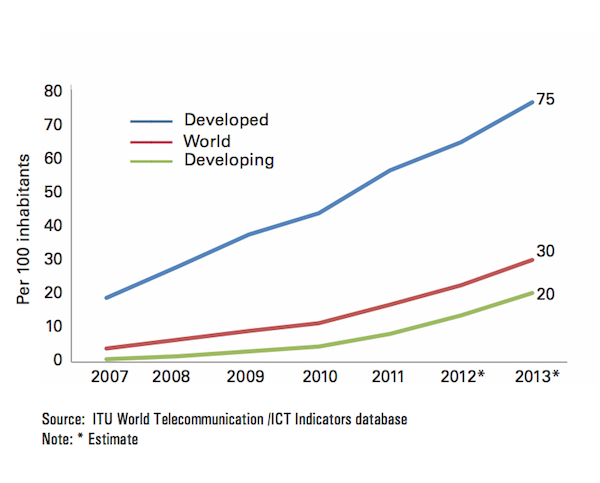
Take a moment to think about it. The mobile market – hardware, software, apps, services, infrastructure – is expanding to just about every corner of the wold. And as mobile connects the entire planet – linking billions of people in real-time from almost any place you can imagine – it is re-constructing how people everywhere engage in shopping, banking, entertainment, work, healthcare and learning.
Mobile Is Everywhere
This isn’t news, of course, mobile’s momentum has been building for years. But when you consider some of the data released this year – and give it time to really sink in – the implications are staggering.
Figures published earlier this year from the UN’s International Telecommunication Union (ITU), for example, reveal the amazing spread of mobile connectivity. According to the ITU’s “facts and figures” publication, mobile penetration rates (pdf) are now about equal to the global population – including an 89% penetration rate in “developing countries,” which currently have the highest mobile growth rates.

In other words, nearly everyone on the planet has a mobile phone – or will have one soon enough.
The ITU report also notes that “mobile broadband” subscriptions have grown from 278 million in 2007 – when the iPhone was first introduced – to 2.1 billion in 2013 – an annual growth rate of 40%.

While larger still in the developed world, since 2010, mobile broadband adoption has grown fastest in developing countries – with rates hitting 82% in Africa and 55% in the Arab states.
Cost Still Matters
One stumbling block to universal mobile penetration, of course, remains cost – at least with respect to data connectivity. The price of the phones and smartphones have dropped in price significantly. Consider that Nokia releases its Asha 501 next month – for $99 or less (without being subsidized by a contract). The Asha 501’s specs are surprisingly robust, although the device is initially designed only for 2G networks.

Android smartphone prices could go even lower. There are already numerous Android phones available in the developing world for less than $100 (off-contract). And venture capitalist Marc Andreessen recently told Bloomberg, expect $50 Android smartphones to be available this year.
Mobile broadband, though, is still relatively expensive in the developing world. As the ITU notes, whereas an “entry level mobile broadband plan” represents approximately 1-2% of per capita income in developed nations, in developing nations the cost ranges from 11-25% of per capita income.” That said, mobile broadband is often cheaper than wired-broadband in developing countries.
Mary Meeker’s Metrics
If the ITU’s numbers aren’t enough to convince you that mobile is eating the world, look back just a bit farther.
At the end of 2012, Mary Meeker, an analyst with Kleiner Perkins Caufield and Byers, offered data on global Internet trends and the stunning rise of mobile was plain. There are already, she noted, more than 1 billion smartphone subscribers worldwide. In addition, since the fourth quarter of 2010, smartphone and tablet sales have exceeded PC sales – and the growth trends continue to favor these newer devices. Mobile devices now account for 13% of global Internet traffic – and rising.
2012 KPCB Internet Trends Year-End Update
from
Kleiner Perkins Caufield & Byers
If this keeps up, and all indications are that it’s not going to stop any time soon, the global trend toward mobile will reach every corner of the globe and affect just about every aspect of our lives.
Image courtesy of Shutterstock.

















